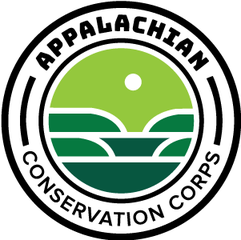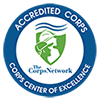Sharing Park History
Individual PlacementsBy Laura Boaggio
Jan. 24th, 2024 | Washington, D.C. — When we think of national parks, our minds often go to stories of rangers protecting the land or battles that altered history. But rarely do we think of the people who wrote about those stories, and how vital they are to the park system.
After graduating from James Madison University in 2022, Appalachian Conservation Corps alumni Easton was searching for a job in museum work when she came across our Cultural Resource Sharing internship. The listing appealed to her because in addition to submitting a resume, it asked applicants to answer a question in a one-to-two paragraph format.
“‘Oh that’s kind of up my alley, I wonder if that’s the type of work that I’ll be doing,’” she recalled thinking.
Sure enough, Easton has spent the last year reading park service reports, studies and documents to distill the information into shareable material for park staff and the public.
Easton finished up her service term this month as our Cultural Resource Information Sharing intern with the National Capital Region, based out of Washington, D.C. She worked with the Capital Region’s Information Specialist and cultural resource programs to highlight underrepresented stories in the National Park Service.
To do this, Easton collaborated with park department heads in history, archaeology, cultural anthropology, Civil Rights history and other areas to identify reports and studies that they wanted to share more widely. From there, Easton helped create articles and other communication materials to share both internally with NPS staff and externally to the general public.
By sharing information online, it’s accessible to people who might otherwise not be able to see it, due to barriers keeping them from visiting the park, Easton said.
ACC Alumni Easton
One project that Easton worked on summarized information found in a 2021 NPS historic report on African American schools in the south during the Reconstruction Era. The report highlighted ten case studies that represented the types of sites that may be found while visiting national parks, according to the article. The idea for this project came from the National Capital Region’s regional historian at the time, Easton said.
For this project, Easton was tasked with creating an interactive map of the ten sites. Learning to use the mapping software was difficult, since she didn’t have prior experience with it, she said. Luckily, a fellow coworker helped Easton learn the ropes and she was successful by the end of the project.
She encountered another first while working on a project for Manassas National Battlefield Park. The battlefield has a collection of five Civil War uniforms on display that were worn in the Battle of Manassas. Since they are textile artifacts, they aren’t supposed to be on display for very long and are required a rest period in the next 5-10 years. While working with the battlefield, Easton and her supervisor suggested creating an online photo gallery for people to view the uniforms during their rest period.
The Capital Region’s museum program helped train Easton on how to take museum collection photos: what type of lighting and camera settings to use, the proper backdrops to include and how to catalog the photos afterward.
The online catalog can be found here, with summaries on the history of each uniform. One of the most striking pieces, Easton said, is a Virginia Military Institute cadet jacket worn by a 17-year-old cadet who led the charge and was ultimately shot and killed. There is still a bullet hole in the right shoulder of the jacket.
Along with technical challenges, Easton faced the difficult task of making sure all the communities she was writing about were properly represented. While a heavy undertaking, it’s also an extremely important one.
“In this position, I realized there’s a lot of different ways of giving back to the community,” Easton said. “Like making sure that underrepresented groups, communities and stories are being highlighted.”
Many folks might not see themselves represented in park history. A lot of historical discussions have been one-sided and erased certain impacts, Easton said. By sharing stories and representing all communities in the region, it gives park visitors a sense of identity in the story.
Another project Easton helped with was about the history of gender equality in NPS Living History demonstrations.
The article summarizes legal challenges involving two female interpreters performing artillery demonstrations at Antietam National Battlefield in the 1980s. These cases were the catalyst for the entire NPS to correct its policies around equality in living history programs, according to the article.
The project began in August but wasn’t published until December, after several rounds of edits and proofreads.
“It was a real labor of love,” Easton said.
Prior to this internship, Easton said her impression of the park service mostly revolved around the outdoors. But now, she’s familiar with both the cultural and natural resources sides of NPS.
“They work on different things to support the parks and the communities that the parks are supposed to represent,” Easton said.
One of the NPS’s goals is to revitalize communities and preserve local history — throughout her internship, Easton got to witness this in action. For example, if the park wanted to install new signs along the trails of Piscataway Park in Maryland, they would consult the Piscataway-Conoy Tribe of Maryland, she said.
This intention transferred over to written content as well, Easton said.
“They do collaborate directly with the people who they’re trying to tell stories about,” Easton said.
In addition to her internship, Easton spent time volunteering as a tour guide at the Mary McLeod Bethune Council House National Historic Site, which once served as headquarters for the National Council for Negro Women and is now a museum and national historic site dedicated to NCNW founder Mary McLeod Bethune.
While she finished her term with ACC this month, her published work will continue to reach audiences in the National Capital Region and throughout the country. Check out some of her other project work here:
Series: African American Communities Along the C&O Canal
Subsistence Fishing on the Potomac and Anacostia
Archeological Overview of Manassas National Battlefield Park
It Takes a (Waterford) Village: Expanding the Bounds of National Historic Landmarks





